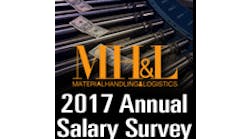Production at this plant is projected to be 325,000 engines per year. More than 800 employees now work at the plant, the level before the facility was closed in 2000. With the reopening, the Cleveland manufacturing site's engine facilities at plants No. 1 and No. 2 have the combined capacity to produce more than 1 million engines a year.
Material Handling Management toured Plant No. 1 shortly after its reopening and interviewed two of the Ford project’s key players: Adrian Price, manufacturing manager, and Steve Orr, material planning and logistics superintendent. Those interviews follow. — Tom Andel, chief editor
MHM: This plant is being touted as a showcase of flexible manufacturing. Explain what you mean by flexible.
Price: Our crankshaft line can produce any kind of crankshaft, steel or cast iron; you'll see a flexible cylinder head line system consisting of 84 identical CNC machines. That gives us flexibility to make any cylinder head that Ford has a design for. The assembly line has the flexibility to make an in-line 4 or a V6 or an in-line 6 or a V8. This is the first Ford plant in North America that has all these elements. We have a couple sister plants that are similar in design, both in the UK.
Price: We did a lot of work on material flow and reduced material handling vehicles in the building. Making sure there's a good process flow is important from a flexibility standpoint. It will ensure we have the flexibility to do a changeover in the future.
On the cylinder head line we use a radio frequency [RF] tag that sits on the pallet with the cylinder head and goes throughout the line so we know where the head's been. Traditionally we used an RF tag on the assembly line to keep data, but we don't normally have machined components with that data.
MHM: What other forms of automatic identification and data collection are used?
Price: On the crankshaft line we're in the process of launching a system with a 2D data matrix code so we can read the data on a crankshaft and pass that over to the assembly line. That will let us track all the way to the customer plant. We also have a system that enables us to track a particular engine serial number to a rack and that rack onto a certain truck and that truck to a customer plant. Then once it arrives at the customer plant, that's logged into their system and they know which vehicle has what engine. They can read a VIN number on a vehicle and we can tell what day the cylinder head or crankshaft was made and what machines it went through. Hopefully we won't get into a situation where we're tracing those things out into the vehicle plant. We want to contain everything in the engine plant.
MHM: How does your system of quality control differ from the industry norm?
Price: We have a system called "no fault forward." In a traditional system there are a lot of repair loops. We don't have those in our assembly line because we don't want to pass any quality defects anywhere through the system. This plant has no hot test. We never put gas into an engine. It's better for the environment and for the workforce. What enables us to do that is a lot of in-process checks that don't allow us to build those defects in the first place. This is the first Ford plant that has no hot-test capability whatever. From a material handling standpoint we're not handling dangerous material. The enabler for this is we have a lot of in-process test equipment strategically placed in the system. That means you don't pass that stuff down to the end of the process. We've been developing that with our suppliers for a long time.
MHM: Why is Ford intent on the cookie-cutter approach to plant design?
Price: We're creating a common baseline, so our sister plants can let us know what issues they find and ways around them. That way when the next generation of plants come along they're not creating anything new. They just get the next evolution of what we've done. We have common planning and engineering methods involving the layout of the system, the type of equipment and how it's designed. We're launching three plants simultaneously around the world. Those would have been engineered discretely. Now we pay the design costs once and we get more integrity in the build. That also means maintenance is easier because with 84 CNC machines that are the same, that's a lot of equipment, but they have the same maintenance procedures. We're creating a system and strategy that grows and evolves and there isn't a revolution each time there's a change.
MHM: What's the idea behind "raising the roof" of this plant?
Price: We jacked up the roof to accommodate the cylinder head line. We use a lot of gantries in that line. We could have engineered it so we wouldn't have had to raise the roof, but we'd end up with customized units with poor reliability and a system that wasn't common. We made a choice that the units would be identical and we'd get the benefits from engineering and consistency and reliability of the system rather than compromise the integrity of the process.
MHM: Describe manufacturing flow here.
Price: There's a crankshaft line, cylinder block line, two head modules, and these feed into an assembly area in the middle. We have a kitting area to minimize errors on the line. Whenever you have complexity on a line those guys have to choose. To minimize that, our people in the kitting area are told by the system which parts to load in each kit. It's error proof because of a pick-to-light picking method. That box is put on a structure in front of the pallet on which the engine travels through the assembly line. The pallet moves into the station and as it moves down the line, the person picks up the part, assembles it to the engine, with having to choose only one part. From an efficiency standpoint, instead of that engine indexing in front of him and stopping, it's moving within his work zone and there's value-added time where he's working on the engine. Previously he would have grabbed his parts while the engine was indexing into the station, wait for it to stop, do his work on it, then wait for it to index out.
MHM: The "pallet" you use to carry the engine through production is a new design for your process. What's the concept behind it?
Price: A traditional assembly pallet has struts underneath. The bottom of the block sits on the struts and then you move it around to face the operation you're doing. On this line, the engine sits on an adapter plate. That adapter plate sits on a stand and the area around the engine is completely open so the people can work around it and spin it around. Once it gets into the machine, that whole adapter plate can be lifted out and the machine can go from side to side, manipulate it, hold it and drop it back onto the pallet. If we wanted to change the design of the engine or build a different engine all we'd have to do is drop a different adapter plate into the same cradle. That's better ergonomically because the people can get all around the engine where before anything beneath it was obstructed and you had to spend time turning the engine over.
MHM: You've obviously taken ergonomics seriously. What are some other safety issues you've addressed?
Price: One of our biggest safety issues is the interaction between people and powered material handling vehicles. Seventy-five percent of our reports are near misses between pedestrians and lift trucks. We've implemented a system of tuggers [Taylor-Dunn] and material handling carts [K-Tec] that can carry 3,000 pounds while still meeting our ergonomic requirements for pushing loads onto the line. That's related to the design of their wheels and bearings. We worked with Taylor-Dunn on the tuggers so they'd be more maneuverable. Before, a lift truck would put the load on a tilt table. Now we tug the loads in without lift trucks. Before we were stacking the cranks in like cord wood and they were too tight. Now only two drivers unload all these carts.
MHM: Steve, were automatic guided vehicles considered?
Steve Orr: We looked at doing laser-guided AGVs, but we were struggling with how we were going to get the parts to the line. The K-Teck cart comes with a rotating platform. What gets costly is you buy these lift tables and they lift and rotate. With these carts being the right height for the assembly lines they serve, we didn't need a rotating lift table because the cart rotates for you already.
MHM: Tell us more about the ergonomics of the assembly line.
Orr: Before, people would have four different pallets of parts from which to pick. Now with these racks they can just grab the cams they need from one pallet. K-Tec made this for us. A person on the line can just rotate these racks and grab the ones they need instead of walking down the line to four different pallets. This saves their walk time. With 12 different parts in a kit, there would be 12 different pallets on the line. We're a service organization and my main goal is to service the person on line. I want this person to worry just about building an engine. I don't want them to worry about going back to get parts or worry about whether they have the right parts. I want the parts to be there JIT and ergonomically placed.
MHM: How does the pick-to-light assembly line fulfillment process work?
Orr: The person in “the market area” [where supplies are stored] will hit a button, the lights will flash, indicating which part to pick and what sequence to pick them in. If the person picks the wrong part, the system will beep. Once he puts enough of a certain part in, another light will flash. Before, you wouldn't have been able to do assembly with one person because the parts would have been too spread out. Here, the person at the assembly station just attaches the parts in the kit to the engine. Before, he would have been working out of a series of pallets. And now the operator on the line calls for a kit whenever he needs one. Ford and WhereNet co-developed a wireless “call” system known as WhereCall to bring parts to the line as needed. Our goal here in Cleveland for material handling is to be a service organization. We're going to give assembly what they need to build the best engine in the world.
Material Handling System Suppliers
• Material handling carts: K-Tec, www.k-tec.bz
• Tuggers: Taylor-Dunn, www.taylor-dunn.com
• Lift trucks: Hyster, www.hyster.com
• Wireless Inventory “call” system: Wherenet, www.wherenet.com

